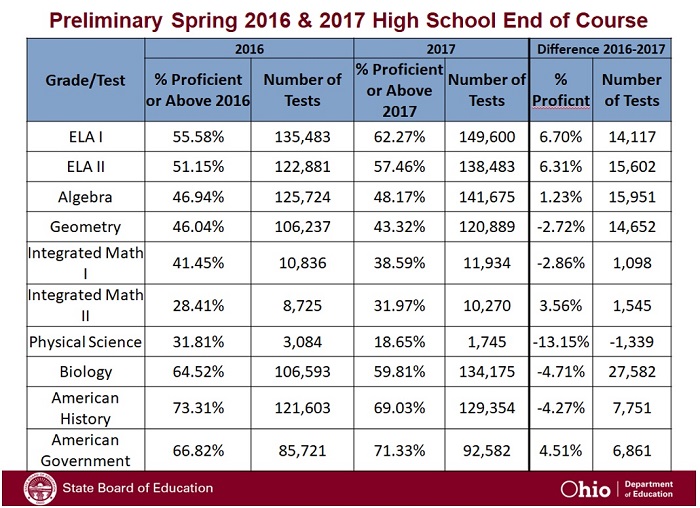Back in July, the Columbus Dispatch posted an article entitled “Ohio high schoolers test poorly in math.” The story emerged from a State Board of Education meeting at which the Ohio Department of Education (ODE) shared preliminary assessment results from the 2016-17 school year.
Lost in the headline was the promising news that the results pointed upward for grades 3-8. Of the sixteen state tests administered in those grades, only one—5th grade math—had a lower proficiency rate than in 2016. The tables below show the results for English language arts and math in grades 3-8.


The high school results, however, were more disheartening. The table below shows that five of the ten End Of Course subject exams showed decreases in proficiency: geometry, integrated math I, physical science, biology, and American history.

How concerned should we be? There’s no denying that thousands of students still aren’t doing very well in Ohio’s high schools, particularly in math. There’s plenty of work to be done.
But let’s pause before declaring a crisis. When presenting the EOC data, ODE staff was clear that the 2016-17 preliminary results do not differentiate between students taking tests for the first time and students retaking them. Since EOC results are tied to students’ graduation requirements, those who do not perform well when they first sit for the exam may retake the test. It’s certainly possible—some might say plausible—that students who struggle to pass a test the first time are likely to struggle again on their second attempt.
Could this have impacted proficiency? The department doesn’t yet know how much of the increase in test takers was due to retakes. But enrollment numbers seem to show that the increase in test takers wasn’t just a matter of increased enrollment. And as you can plainly see in the chart above, all but one of the EOC exams had an increase in the number of test takers, and five of the assessments had a ten-percent or more increase in the number of tests administered.[1]
It’s possible that a portion of the drop in proficiency on some assessments was driven by students who were re-taking assessments after having struggled on their first attempt. To determine whether Ohio high schoolers are doing better or worse, we need to be able to look at results for first-time test takers compared to other first-time test takers. That disaggregation is expected in the coming weeks, along with school and district report cards.
We’d also be wise to remember that the EOC exams are part of a concentrated effort to raise expectations for Ohio students. Here at Fordham, we’ve long warned that truly raising the bar would lead to lower test scores before it led to higher ones. The previous state assessments, known as the Ohio Graduation Tests (OGTs), were shockingly easy for most high schoolers because they assessed eighth grade-level content. The EOCs are more rigorous by design. Policymakers and school officials recognized that parents and taxpayers were being misled by state test results that didn't reveal actual proficiency, and they committed to raising expectations.
But almost immediately after doing so, consequences got real, and folks started to vacillate. Ohio made national news when officials opted to lower cut scores instead of holding the line as other states were doing. Most recently, the state legislature opted to create alternative graduation pathways for the class of 2018 in response to widespread fears that too many students would fail to pass the same EOCs discussed here. Ohio has a history of sidestepping accountability—and panicking too soon about poor test scores is a bit like offering a pyromaniac a match.
Until the department disaggregates first-time test takers and re-takers, there’s no way to know whether scores are rising or falling. Before the legislature decides to lower expectations for additional graduating classes based on poor test scores, they would be wise to remember why we raised the bar in the first place: Far too many Ohio students are stumbling when they encounter the higher bars of college and the real world. They deserve better.
[1] The only test that didn’t have a higher number of takers but still saw a decrease in proficiency was physical science, which is in the process of being phased out and replaced by biology.
